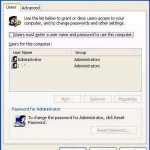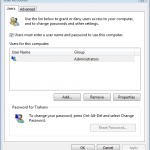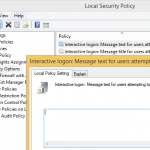In standalone computer which does not join any Active Directory (AD) or Windows NT domain as a member, user can configure in such as way that operating system auto login to console or desktop area after booting up (see how to make Windows XP automatic login and enable automatic log on in Windows).
However, if the PC is domain member and configured to logon to domain, automatic logon feature cannot be configured through graphical user interface (GUI). In Windows operating system including the Windows XP, Windows Vista, Windows 7, Windows 8, Windows 8.1 and the newest Windows 10, the option for “users must enter a user name and password to use this computer” is missing, hidden and disappearing in User Account window on domain-based system, even though user belongs to local user or local admin privilege group. In a domain-joined computer, Windows can still be set to automatically log on selected user account by configuring the settings in the registry.
Note that the user name and password credential for auto login will be saved and stored in the Windows Registry, and can be read by anybody who can physically gain access to the computer, or remotely connect to the registry by the Authenticated Users group. Hackers or malicious users can also gain access to everything that is on the computer, including any network or networks that the computer is connected to. Thus, enable and turn on automatic logon on a domain environment will severely compromise the network security.
Follow these procedure to force Windows to skip and bypass asking user for user to select or input user name and password:
- Click Start, click Run, type regedit, and then click OK. In Windows Vista, simply type regedit in Start Search and hit Enter.
- Navigate to the following registry key:
HKEY_LOCAL_MACHINE\SOFTWARE\Microsoft\Windows NT\CurrentVersion\Winlogon
- Double-click the DefaultUserName entry, type the user name to log on with, and then click OK.
If DefaultUserName registry value name is not found, create the new String Value (REG_SZ) with value name as DefaultUserName.
- Double-click the DefaultPassword entry, type the password for the user account under the value data box, and then click OK.
If there is no DefaultPassword value, create a new String Value subkey (REG_SZ) with DefaultPassword as the value name.
NoteIf no DefaultPassword string is specified, Windows automatically changes the value of the AutoAdminLogon registry key from 1 (true) to 0 (false) to turn off the AutoAdminLogon feature. - In Windows operating system newer than Windows Vista, DefaultDomainName has to be specified as well, else Windows will prompt of invalid user name with user name displayed as .\username. To do so, double click on DefaultDomainName, and specify the domain name of the user account. If it’s local user, specify local host name.
If the DefaultDomainName does not exist, create a new String Value (REG_SZ) registry key with value name as DefaultDomainName.
- Double-click the AutoAdminLogon entry, type 1 in the Value Data box, and then click OK.
If there is no AutoAdminLogon entry, create a new String Value entry (REG_SZ) with AutoAdminLogon as the value name.
- If exist, delete the AutoLogonCount key.
- Quit Registry Editor.
- Click Start, click Restart, and then click OK.
After computer reboots and Windows starts, system can log on automatically to the preset or predefined user in the registry.





